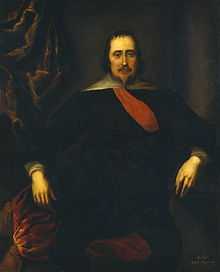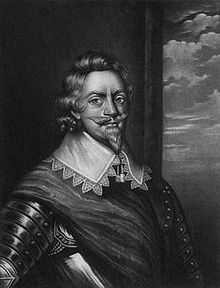Cornwall in the English Civil War
Cornwall played a significant role in the English Civil War, being a Royalist enclave in the generally Parliamentarian south-west.
Civil War military actions in Cornwall and the South West
The English Civil War lasted nearly nine years, having begun with the battle of Edgehill, in Warwickshire, on Sunday, 23 October 1642, and ended with the battle of Worcester, on 3 September 1651. The principal events in Cornwall happened in the following order.
1642
In October 1642, Cornwall was secured for the king when some 10,000 men rose under the command of the local Royalist gentry and drove out the small force of Cornish Parliamentarians who had gathered at Launceston.[1] [2]The Cornish-Royalist Army was formed by Ralph Hopton, 1st Baron Hopton in 1642 and although their first invasion of Devon in November – December 1642 ended in failure the army secured the Cornish side of Plymouth Sound which marked a serious reverse for Parliamentarian forces.
1643

The Battle of Braddock Down
The Battle of Braddock Down near Boconnoc on 19 January 1643 resulted from a parliamentarian counter-invasion of Cornwall. It ended in defeat for Col. Ruthin's Parliamentarian troops by Sir Ralph Hopton. Hopton's victory secured Cornwall for the King and the Royalists resumed the siege of Plymouth with their forces occupying surrounding towns to seal off the city by land.[3][4]
The Battle of Stratton
The Battle of Stratton occurred on 15 May 1643. The Earl of Stamford's Parliamentarian force was repelled by Hopton's men after day-long fighting, with 300 men killed and 1700 captured, and retreated to Bideford. The victories for Hopton with five 'Old Cornish' regiments provided the impetus for campaigns in Devon and Somerset.[5] Taunton and Bridgwater were taken by the Cornish army, but Sir Bevil Grenville was killed in the moment of victory at the Battle of Lansdown in Somerset and Hopton was seriously wounded. Bristol fell to Hopton's Royalist troops, followed by Exeter.[6][7]
On December 13, the Royalists began a heavy bombardment of the northern defences of Plymouth but with little effect. Sir Richard Grenville, 1st Baronet, having previously declared for Parliament, invited his troops to follow him into the King's service and parliament proclaimed him a traitor.
1644
Siege of Plymouth
Sir Richard Grenville arrived in Plymouth in March 1644 to maintain a blockade, but it resulted in a stalemate as the inhabitants obtained enough provisions to survive. Robert Devereux, 3rd Earl of Essex, arrived in command of the Roundhead army of 8000 men and forced Grenville to retreat to Cornwall across the River Tamar.
The Battle of Lostwithiel
- see main article Battle of Lostwithiel
After relieving Plymouth, Essex advanced into Cornwall, reaching Bodmin on 28 July. King Charles meanwhile led the main Royalist army against him, blocking his line of retreat. Caught between Charles and Grenville, Essex took up positions at Lostwithiel and Fowey, hoping for support or evacuation by the Parliamentarian fleet.[8] The Royalists cut off his escape routes by land and on 13 August Charles began his attack. On 21 August, the Royalists took Restormel Castle and Beacon Hill, Lostwithiel. After further sporadic fighting they pushed the Parliamentarians back to Castle Dore above the Fowey river on 31 August. That night the Parliamentarian cavalry broke through the encircling Royalists and escaped to Plymouth. On 1 September the Royalists took Castle Dore and Essex escaped by sea, leaving his 6000 infantry, artillery and baggage train under the command of Sir Philip Skippon, who surrendered the following day. The Royalists confiscated the Parliamentarians' weapons and then allowed them to return to Portsmouth. Afflicted by bad weather, hunger, disease and attacks from local people, 1000 of the disarmed soldiers died along the way. Their time in Lostwithiel saw the vandalism of Lostwithiel Stannary Palace, Jonathan Rashleigh's Menabilly House, the destruction of all the constitutional Charters and Stannary records placed in Luxulyan church for safety. The ensuing debate in London about the unsatisfactory manner of the war led to the passage of the Self-Denying Ordinance. This was the prompt for a professional English army with a unified command, the New Model Army.[9]
1645
In 1645 Sir Thomas Fairfax was appointed the commander of the New Model Army. The Royalist army was also reorganised with Prince Charles becoming the Commander-in-Chief. The Royalists suffered a notable loss at Naseby in Northamptonshire and there were further Parliamentarian gains in the south and west of England. Prince Charles, the war being mainly in the eastern counties, spent a great part of the autumn and winter in Cornwall, principally at Launceston and Truro. Sir Richard Grenville was committed by the Prince to Launceston Prison, for refusing to obey Lord Hopton: he had already quarrelled with General George Goring.[10]
1646
In 1646 the Prince gave Lord Hopton command of the Royalist forces, with William Wentworth, 2nd Earl of Strafford to command the horse and Grenville the foot. Grenville refused and was imprisoned on St Michael's Mount. Hopton advanced from Stratton towards Exeter, reaching Torrington but was confronted by Fairfax's men, and fell back to Stratton. The Roundheads proceeded into Cornwall reaching Launceston on 25 February 1646 and Bodmin on 2 March. Hopton's army was in disarray but he refused to surrender. News at Bodmin of an imminent Irish invasion further damaged the Royalist cause locally and Fairfax offered Hopton terms. The surrender took place at Tresillian Bridge, Truro, on 15 March 1646.
1648
The Gear Rout
The Gear Rout was a Cornish insurrection of 1648 following the end of the First English Civil War. The killing of 70 Cornish Royalists in Penzance on 16 May 1648 prompted a failed rebellion by some 500 Cornish rebels who fought against the Parliamentarian forces of Sir Hardress Waller at a site near the Helford River.[11]
Military figures of the Cornish campaigns


- Jacob Astley, 1st Baron Astley of Reading
- Arthur Capell, 1st Baron Capell of Hadham
- Prince Charles, Duke of Cornwall
- William Coryton
- Robert Devereux, 3rd Earl of Essex (Parliamentarian)
- Thomas Fairfax (Parliamentarian)
- George Goring, Lord Goring
- Bevil Grenville
- Richard Grenville
- Henry Grey, 1st Earl of Stamford (Parliamentarian)
- Ralph Hopton
- Robert Rich, 2nd Earl of Warwick (Parliamentarian)
- Patrick Ruthven, 1st Earl of Brentford
- John Robartes, 1st Earl of Radnor (Parliamentarian)
- William Scawen
- Philip Skippon
- Nicholas Slanning
- John Trevanion
Footnotes
- ↑ Stoyle, Mark (2002). West Britons: Cornish Identities and the Early Modern British State. University of Exeter Press. p. 59.
- ↑ Stoyle, Mark (2005). Soldiers and Strangers: An Ethnic History of the English Civil War. Yale University Press. p. 37-43.
- ↑ The History of Boconnoc ...
- ↑ Battle of Braddock Down from the Battlefields Resource Centre
- ↑ Stoyle, Mark (2008). "The Afterlife of an Army: The "Old Cornish" Tertia, 1643-44". Cornish Studies 16: 26-47.
- ↑ The Battle of Stratton English Heritage pdf file
- ↑ The Battle of Stratton from the Battlefields Resource Centre
- ↑ Stoyle, Mark (2014). "His Majestie’s Sea-Service in the Western Parts: Maritime Affairs in Cornwall during the English Civil War". In Payton, Philip; Kennerley, Alston; Doe, Helen. The Maritime History of Cornwall. Exeter: University of Exeter Press. pp. 110–111.
- ↑ The Lostwithiel Campaign of 1644 The English Civil War Society of America
- ↑ The Cornwall Register; by John Wallis (1847)
- ↑ Stoyle, Mark (2002). "The Gear Rout: The Cornish Rising of 1648 and the Second Civil War". In Stoyle, Mark. West Britons: Cornish Identities and the Early Modern British State. Exeter: University of Exeter Press. pp. 113–133.
Further reading
- Barratt, John (2005) The Civil War in the South-West Barnsley: Pen & Sword Military ISBN 978-1-84415-146-2
- Brown, H. Miles (1982) Battles Royal: Charles I and the Civil War in Cornwall and the West Libra Books ISBN 0-9508009-0-2
- Coate, Mary (1933) Cornwall in the Great Civil War and Interregnum 1642–1660 Oxford: Clarendon Press. 2nd ed. 1963
- Duffin, Anne (1996) Faction and Faith: politics and religion of the Cornish gentry before the Civil War. University of Exeter ISBN 978-0-85989-435-7
- Holmes, Richard (1989) Civil War Battles in Cornwall, 1642 to 1646 Mercia ISBN 0-948087-32-3
- Peachey, Stuart (1993) Stuart Press
- The Battle of Braddock Down 1643 ISBN 1-85804-021-3
- The Battles of Launceston and Sourton Down ISBN 1-85804-019-1
- The Battle of Stratton 1643 ISBN 1-85804-018-3
- Russell, Dennis (2001) Carew: a story of Civil War in the West Country. London: Aidan Ellis Publishing ISBN 0-85628-298-7
- Stoyle, M. (2002) West Britons: Cornish Identities and the Early Modern British State. Exeter: University of Exeter Press ISBN 978-085989-687-0
- (2005) Soldiers and Strangers: An Ethnic History of the English Civil War New Haven, CT: Yale University Press
- (2008) "The Afterlife of an Army: The 'Old Cornish' Tertia, 1643-44", Cornish Studies 16. Exeter: University of Exeter Press. p. 26-47. ISBN 978-0-85989-836-2
- (2014) "His Majestie’s Sea-Service in the Western Parts: Maritime Affairs in Cornwall during the English Civil War", in P. Payton, A. Kennerley and H. Doe The Maritime History of Cornwall. Exeter: University of Exeter Press. p.106-115. ISBN 978-0-85989-850-8
External links
| ||||||||||||||||||||||||||